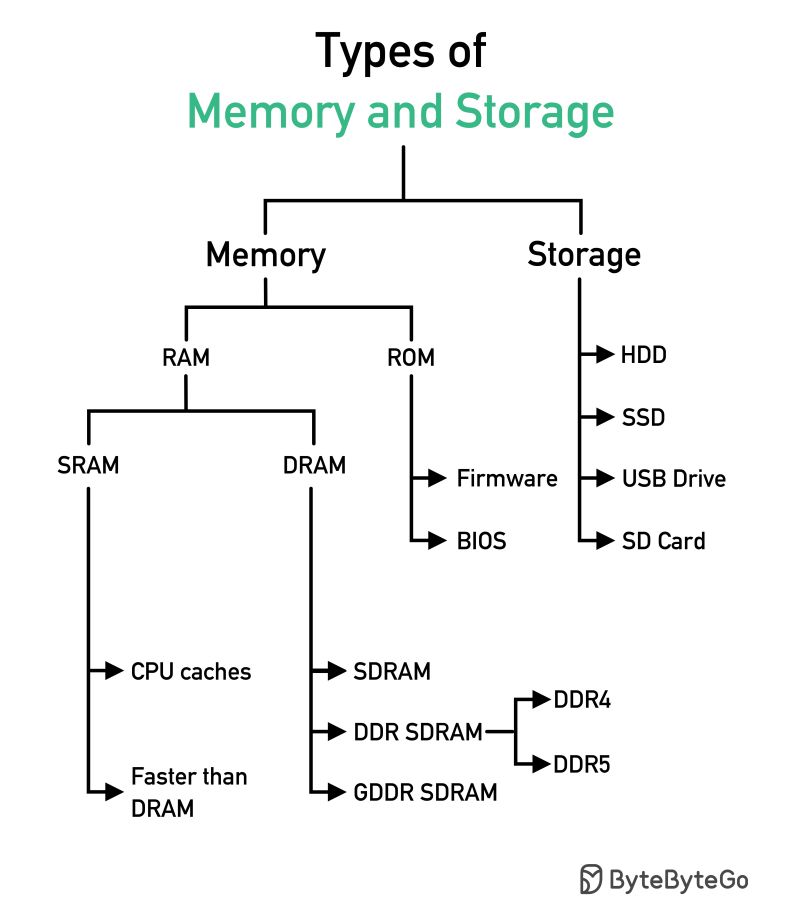| Computer memory, in its simplest form, is any physical electronic component that stores information for immediate use in a computer. It's like the computer's short-term and medium-term workspace where it keeps the data and instructions it actively needs. Think of it as your brain's working memory – the information you're actively thinking about right now.
Without memory, a computer can't do anything. It needs memory to: - Store the operating system: The software that controls the computer's basic functions.
- Store applications: Programs like your web browser, word processor, or games.
- Store data being processed: The information you're working on, like a document you're editing or a website you're browsing.
- Store temporary results: Intermediate calculations or data manipulations that the computer needs for the next step.
Computer memory is generally characterized by: - Volatility: Whether the data is lost when power is turned off (volatile) or remains stored (non-volatile).
- Speed: How quickly data can be accessed (faster is better).
- Capacity: How much data it can hold (more is better).
- Cost: Faster, larger, and non-volatile memory typically costs more.
Types of Computer Memory and Storage on Earth
There are many different types of computer memory and storage, each with its own characteristics and applications. Here's a breakdown of the major categories:
1. Primary Memory (Main Memory): Directly accessible by the CPU - RAM (Random Access Memory): *Volatile, fast, and relatively expensive.* This is the computer's main working memory.
- DRAM (Dynamic RAM): The most common type of RAM. Needs to be constantly refreshed to retain data. Examples include DDR4, DDR5 (the latest standards).
- SRAM (Static RAM): Faster and more expensive than DRAM. Uses latches instead of capacitors, so it doesn't need constant refreshing. Used in CPU caches.
- ROM (Read-Only Memory): *Non-volatile.* Contains firmware, such as the BIOS (Basic Input/Output System), which is essential for booting up the computer. ROM is *usually* read-only, but some types can be programmed (though not easily).
- PROM (Programmable ROM): Can be written to once.
- EPROM (Erasable Programmable ROM): Can be erased using ultraviolet light and then reprogrammed.
- EEPROM (Electrically Erasable Programmable ROM): Can be erased and reprogrammed electrically. Flash memory (see below) is a type of EEPROM.
2. Secondary Storage (External Storage): Persistent storage for data and programs - Magnetic Storage: *Non-volatile.* Stores data by magnetizing a thin film on a disk or tape.
- Hard Disk Drives (HDDs): Rotating platters coated with magnetic material. Relatively cheap but slower than solid-state drives. Still commonly used for large storage needs.
- Magnetic Tape: Used for archival storage and backups. Very high capacity, but access is sequential, making it slow for random access.
- Optical Storage: *Non-volatile.* Stores data using lasers to read and write patterns on a reflective surface.
- CD-ROM (Compact Disc Read-Only Memory): Read-only optical disc.
- CD-R (Compact Disc Recordable): Can be written to once.
- CD-RW (Compact Disc Rewritable): Can be written to and erased multiple times.
- DVD (Digital Versatile Disc): Higher capacity than CDs. Also available in ROM, R, and RW formats.
- Blu-ray Disc: Even higher capacity than DVDs. Also available in ROM, R, and RW formats.
- Solid-State Storage: *Non-volatile.* Stores data electronically in semiconductor memory cells. No moving parts, making them faster and more durable than magnetic storage.
- Solid-State Drives (SSDs): Uses NAND flash memory. Much faster than HDDs. Becoming the standard for laptops and desktops.
- USB Flash Drives (Thumb Drives): Small, portable solid-state storage devices.
- Memory Cards (SD Cards, MicroSD Cards, etc.): Used in digital cameras, smartphones, and other portable devices.
- eMMC (Embedded MultiMediaCard): A type of flash memory commonly used in smartphones, tablets, and other embedded systems.
- Other Emerging Storage Technologies:
- 3D NAND Flash: Stacks multiple layers of flash memory cells vertically to increase density and capacity.
- ReRAM (Resistive Random-Access Memory): A non-volatile memory technology that uses changes in resistance to store data. Promising faster speeds and lower power consumption.
- MRAM (Magnetoresistive Random-Access Memory): Uses magnetic storage elements. Non-volatile, fast, and low power.
- PCM (Phase-Change Memory): Stores data by changing the phase of a chalcogenide material (between amorphous and crystalline states). Fast and non-volatile.
- DNA Storage: Stores data in synthetic DNA strands. Extremely high density, but slow access times and high cost are current limitations.
- Holographic Storage: Stores data as interference patterns within a holographic material. Potential for very high density and fast transfer rates.
Key Differences and Trade-offs - Speed vs. Capacity: Faster memory (like RAM and SSDs) tends to be more expensive and have lower capacity compared to slower storage (like HDDs and tape).
- Volatility vs. Persistence: RAM is volatile (loses data when power is off), while secondary storage (HDDs, SSDs, optical discs, etc.) is non-volatile (retains data).
- Cost: The cost per gigabyte varies greatly between different types of memory and storage.
The material below from Alex Yu is a great resource that is very easy to understand.

Tags: CPU Caches Computer Memory Computer Storage DDR SDRAM DDR4 DRAM EEPROM EPROM GDDR SDRAM PROM RAM ROM SDRAM SRAM  
|
 6,840
6,840  0
0  0
0  1944
1944 